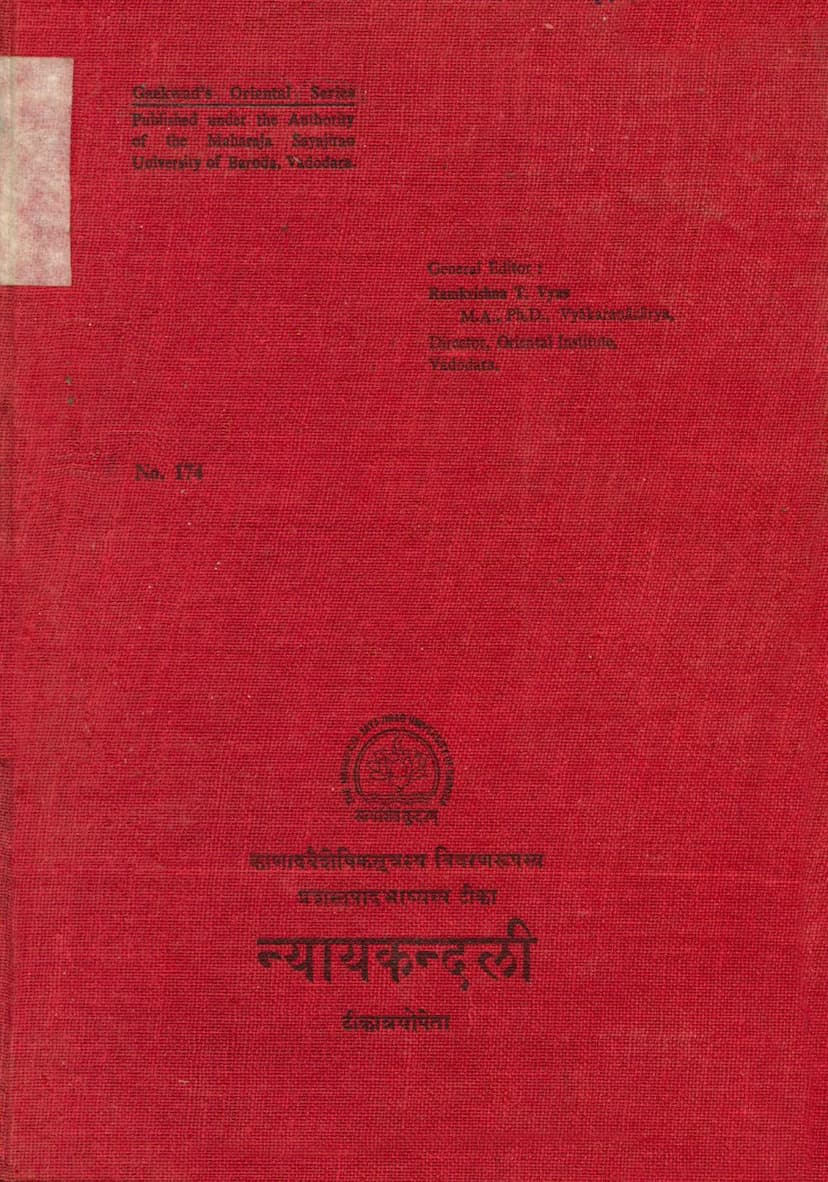Nyayakandali
Added to library: September 2, 2025

Summary
This comprehensive summary of the Jain text "Nyayakandali" is based on the provided catalog link and the initial pages of the text. It focuses on the book's context, authorship, and the philosophical system it addresses.
Book Title: Nyayakandali Author(s): J S Jetly, Vasant G Parikh Publisher: Oriental Research Institute Vadodra Catalog Link: https://jainqq.org/explore/004336/1
Core Content:
- Nature of the Work: Nyayakandali is identified as a tika (commentary) on the Prasastapadabhasya, also known as Padarthadharmasangraha. The Prasastapadabhasya is a crucial and pioneering work on Kanada's Vaisesika Sutras, a foundational text of the Vaisesika school of Indian philosophy. Therefore, Nyayakandali is essentially a commentary on a major exposition of Vaisesika philosophy.
- Commentaries within the Work: The publication of Nyayakandali is significant because it includes three sub-commentaries on Nyayakandali itself. These sub-commentaries are:
- Tippana by Naracandrasuri
- Panjika by Rajasekharasuri
- Kusumodgama by Sidila Vommideva The inclusion of these three commentaries provides a layered understanding of the philosophical discussions within the Vaisesika system as interpreted by Jain scholars.
- Philosophical Context: The text is placed within the context of Kanada's Vaisesika Sutras, which are described as the first available and authentic source of the Vaisesika system. The Vaisesika system focuses on the nature of six categories (Padarthas): Dravya (substance), Guna (quality), Karma (motion), Samanya (genus), Visesa (species), and Samavaya (inherence).
- Prasastapada's Contribution: Prasastapada (also known as Prasastadeva, Prasastamati, or Prasastakaradeva) is credited with an elaborate delineation of the Vaisesika system through his Padarthadharma-Sangraha. While often called a bhasya (commentary) on the Vaisesika Sutras, it is considered an independent treatise based on the sutras. Prasastapada is generally placed in the 4th century AD, possibly contemporary or slightly earlier than Vasubandhu. His work is noted for presenting Vaisesika views in a way that accommodates or responds to Buddhist philosophical concepts, though without direct controversy.
- Prasastapada's Key Developments: Prasastapada's work is highlighted for giving a new turn to the realistic system of Vaisesika philosophy by establishing the external, objective reality of Samanya, Visesa, and Samavaya (previously considered subjective realities by Kanada). He also expanded the list of qualities from seventeen to twenty-four. The treatise covers essential Vaisesika tenets like the theory of atoms (Paramanuvada), the nature of relation (Sambandha), theories of creation and destruction, causation, the Self (Atman), the concept of number (Sankhya), and the role of merits and demerits in liberation.
- Controversies and Differences: The text mentions a point of contention between Vaisesikas and Naiyayikas (followers of the Nyaya school) regarding the perceptibility of Samavaya (inherence). While Vaisesikas (like Prasastapada) infer its existence, Naiyayikas like Udyotakara consider it perceptible. The commentaries are noted for tactfully suggesting these as traditional differences between the two closely related schools.
- Significance of Nyayakandali and Sridhara: Sridharacarya, the author of Nyayakandali, is recognized for securing an eminent place in the scholastic tradition of Nyaya-Vaisesika. His work is described as a valuable commentary on Prasastapadabhasya. Sridhara's composition date is given as 913 Saka Samvat (991 AD), and his native place was Bhurisresta in Radha (Bengal). He wrote Nyayakandali at the request of Sri Pandudasa. Nyayakandali played a specific role in preserving the classical edifice of Nyaya-Vaisesika philosophy against criticisms from Mimamsakas and Bauddhas, often providing dialectical and abstruse explanations. The included sub-commentaries are expected to aid in understanding these potentially difficult sections.
- Key Commentators:
- Naracandra Suri: Author of Tippana, the oldest of the three sub-commentaries. He was a pupil of Devaprabhasuri and known for works in grammar, literature, and Jain literature. His Tippana is described as a short, running, precise, and lucid commentary that clarifies points and sometimes corrects earlier commentators like Vyomasiva.
- Rajasekhara Suri: Author of Panjika. He belonged to the Harsapuriya Gaccha and was a pupil of Sri Tilakasuri. His Panjika is a short yet comprehensive commentary, providing abundant pratikas (quotations) from Nyayakandali, offering clarity and helping settle readings. He shows reverence for Naracandra Suri.
- Sidila Vommideva: Author of Kusumodgama. His origin might be Southern. He is described as a brave warrior and a master of dialectics, presenting elegant and explicit commentaries. He has a peculiarity of initiating fresh discussions by anticipating counter-arguments. His commentary is seen as a lucid and useful handbook for first-time readers of Nyayakandali.
- Editorial Effort: The publication is a result of a significant project undertaken by the Oriental Institute, Vadodara, starting in 1970. It faced challenges, including the untimely demise of Dr. J. S. Jetly in 1972 while he was working on the project, and subsequent delays in printing. Dr. Vasant G. Parikh took over and completed the work, which was eventually published in one volume instead of the initially planned two. The publication received subvention from the University Grants Commission.
Overall Significance:
The Nyayakandali, with its three Jain commentaries, is presented as a vital resource for understanding the Vaisesika system, particularly its realistic phase and its engagement with Buddhist thought. It serves as a tribute to the scholarly efforts of Dr. J. S. Jetly and Dr. Vasant G. Parikh, and contributes significantly to the study of Indian philosophy, especially the Nyaya-Vaisesika tradition, from a Jain perspective. The sub-commentaries are highlighted for their explicitness and lucidity, making the often abstruse Nyayakandali more accessible.